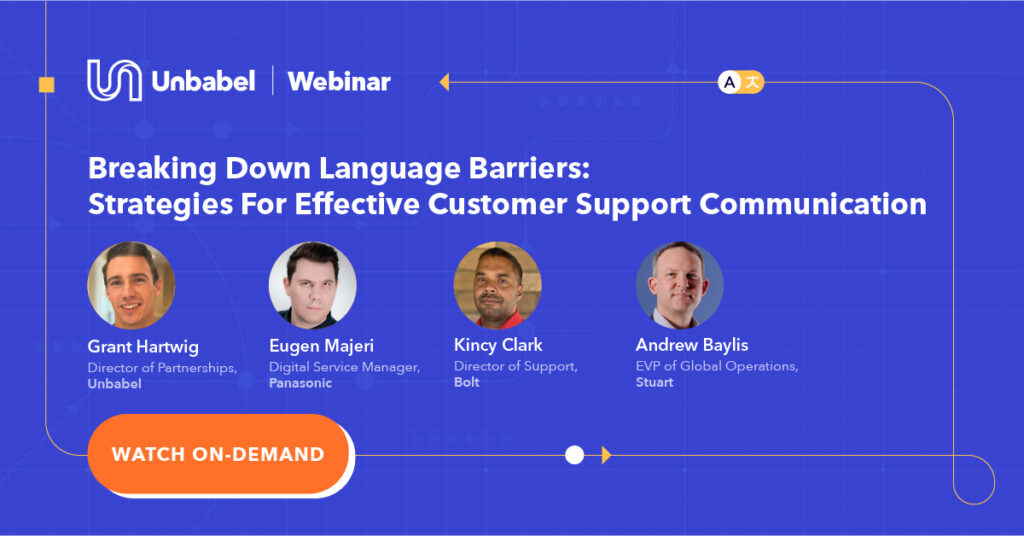Many companies strive to achieve a global presence, but in order to succeed in international markets, leaders need to be confident that their brand can speak the language of all of their customers.
From leveraging technology, especially AI, alongside hiring customer service agents who understand the nuance of many languages, to collaborating with business process outsourcing, there are multiple ways to ensure your customers receive a personalized experience in their native language. So what lessons can you learn from those experts who have successfully overcome the language barrier?
We gathered a panel with Eugen Majeri, Digital Service Manager at Panasonic, Kincy Clark, Director of Support at Bolt, Andrew Baylis, EVP of Global Operations at Stuart, and Grant Hartwig, Director of Communications at Unbabel to dive into these challenges and discuss how to break down language barriers and contribute to an improved customer support program. Here’s what the experts had to say.
What to Expect When Expanding Globally
As a business expands globally, they have to be able to properly and efficiently scale. This means you must consider how to adapt your customer service strategy to suit the needs of the new customer base in new markets while maintaining brand and service consistency for already existing customers.
“In most cases, we’re looking at the scalability of where we actually locate our customer support teams,” says Andrew Baylis of Stuart and Grant Hartwig. “Then you go into the language needs, which luckily now is less of an issue as there used to be 6 years ago in our industry. But definitely understanding your customer base is clearly a requirement from that side.”
“And I think the other thing is to be really aware of country specifics,” Eugen with Panasonic added. “When it comes to culture, the approach, and the expectations of the customer base that you’re serving for that particular region or country is really, really crucial.”
With customer expectations and satisfaction being such a critical part of global expansion, the journey and training of the customer support teams cannot be overlooked.
“I think the other [key] thing [to consider] is around a robust onboarding process,” Eugen continues. “We are sometimes under pressure to really get our colleagues onboarded and out there on the front lines supporting our customers, and we sometimes tend to rush the process itself and the amount of time we allow them to actually get accustomed to our business processes and all of that.”
Overcoming the Hurdle of Language Barriers in Customer Service
Once businesses establish the need and desire to expand globally, how can a business tackle language barriers and ensure efficient communication, especially with something as important as customer service?
“Up until about, I would say 18 months ago, it was really on how our BPO was able to scale a specific language,” shared Andrew. “Now we can actually control that language flow and we can consider the culture, in a way, through sort of macro or canned responses and therefore we don’t have that kind of scalability issue.”
Businesses should strive to focus on cultural nuances and idiosyncrasies by drilling down into each area and training agents properly.
“[Panasonic] actually built a center of excellence for written support where we can really focus on that kind of [nuanced] communication,” shared Eugen. “That’s where technology comes into play and we can really leverage English speakers, but also support other languages through that excellence center.”
“[Stuart is] very strict around the onboarding and the continuous upskilling of the teams,” Andrew says. “We have an LMS in place with the full training. We have a very strict glossary of terminology that we can actually use, as well, in some of our markets depending on the kind of interactions with our partners.”
Optimizing Technology to Support Customer Service Translation
While customer service agents, continued training, and onboarding play pivotal roles in customer service, technologies such as AI and machine learning can elevate the customer experience while also cutting costs.
“My core role is to really look into how we can make use of technology to really build great customer experiences,” Eugen goes on to say. “So I can call out two main use cases where we really went and made the most out of the latest technology that we have at this moment. One is in our learning platform. The other one is obviously around translation when it comes to our written support, which we’re working on with Unbabel.”
“We have a long tradition of using human-only translations,” he continues. “And it was really about a cultural shift in terms of demonstrating the power of technology and humans working together to really make the best out of the situation.”
And while AI can be a powerful tool in translation, it can also greatly impact scalability even beyond customer service.
“We acquired a company last year that had multilingual support,” Kincy Clark at Bolt shares. “And they were hiring local people to speak the native language, which created some interesting considerations around local laws and compensation. But one of the key technologies was routing – just getting questions – and that’s relatively easy to do, but I think it’s something people often overlook. It’s just like, ‘How are you getting the right messages to the right people and just making sure you have a scalable infrastructure for that? And where there could be some complexities.’ So there’s just some amazing opportunities that are coming with the tooling, [and I’m] really looking forward to seeing more and how people apply it.”
Choosing the Right Translation Partner and Technology Stack
“When looking at technology and how you want to really implement it across the board, there’s also lots of considerations you need to play or take into account,” Grant Hartwig from Unbabel poses to the group. “What are some of the other things that you would say either are limitations or just factors that you try to be very mindful of when you’re making these big decisions on finding what that right next vendor or technology to incorporate into the plan is?”
“One thing that has bit me in the backside more than once is the partner not having a complete understanding of labor laws as they kind of relate back to my needs,” Kincy shares. “A lot of European countries will have very different limitations on hours worked, compensation rates, and things like this. That’s one that often doesn’t get discussed, but I think it’s important to do some research.”
But limitations aren’t the only thing to consider, there are also opportunities to be had too.
“This is more of an opportunity when it comes to technology in general and utilizing it from a frontline perspective,” Eugen says. “So if you’re thinking about a day in the life [of an agent], they usually have to use sometimes ten, 15 different tools on a day-to-day basis to do their job. At least in our case, that was the situation for quite some time, so my interest is in getting as much integration as possible. I envision a day where the frontline agent sits down and he just starts one app, and it really has everything they need, even if we’re using different vendors and different software.”
“It’s just being able to use AI, for example, to recognize when someone is reaching out via any channel, creating the case, checking for cases,” he continues. “This way, we can actually just focus on them making the most out of human interaction and really focusing on giving the customers the right answers and the right time.”
Interested in learning more about breaking down language barriers in customer service? Watch the full webinar here.












